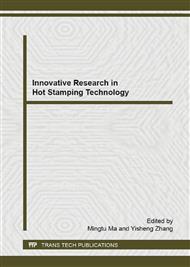[1]
J. Hardell, B. Prakash, High-temperature friction and wear behaviour of different tool steels during sliding against Al-Si-coated high-strength steel, Tribology International , vol. 41, pp.663-671, (2008).
DOI: 10.1016/j.triboint.2007.07.013
Google Scholar
[2]
J. Hardell, L. Pelcastre and B. Prakash, High-temperature friciton and wear characteristics of hardened ultra-high-strength boron steel, Journal of Engineering Tribology, vol. 224, pp.1139-1151, (2010).
DOI: 10.1243/13506501jet737
Google Scholar
[3]
J. Hardell, E. Kassfeldt and B. Prakash, Friction and wear behaviour of high strength boron steel at elevated temperatures of up to 800 °C, Wear, vol. 264, pp.788-799, (2008).
DOI: 10.1016/j.wear.2006.12.077
Google Scholar
[4]
C. Dessain, P. Hein, J. Wilsius, L. Penazzi, C. Boher and J. Weikert, Experimental Investigation of Friction and Wear in Hot Stamping of Usibor 1500P, in International Conference of CHS2, Luleå, Sweden, (2008).
Google Scholar
[5]
M. P. Pereira, W. Yan and B. F. Rolfe, Sliding Distance, Contact Pressure and Wear in Sheet Metal Stamping, Wear, vol. 268, pp.1275-1284, (2010).
DOI: 10.1016/j.wear.2010.01.020
Google Scholar
[6]
M. P. Pereira, J. L. Duncan, W. Yan and B. F. Rolfe, Contact Pressure Evolution at the Die Radius in Sheet Metal Stamping, Journal of Material Processing Technology, vol. 209, pp.3532-3541, (2009).
DOI: 10.1016/j.jmatprotec.2008.08.010
Google Scholar
[7]
LS-DYNA Keyword User's Manual, Version 971, CA, USA: Livermore Software Technology Corp., May, (2007).
Google Scholar
[8]
J. O. Hallquist, LS-DYNA Theoretical Manual, LSTC, (1998).
Google Scholar
[9]
P. Åkerström, G. Bergman and M. Oldenburg, Numerical implementation of a constitutive model for simulation of hot stamping, Modelling and Simulation in Materials Science and Engineering, vol. 15, pp.105-119, (2007).
DOI: 10.1088/0965-0393/15/2/007
Google Scholar
[10]
P. Åkerström, M. Oldenburg, Austenite decomposition during press hardening of boron steel-Computer simulation and test, Journal of Material Processing Technology, vol. 174, pp.399-406, (2006).
DOI: 10.1016/j.jmatprotec.2006.02.013
Google Scholar
[11]
P. Åkerström, M. Oldenburg, Numerical simulation of a thermo-mechanical sheet metal forming experiment, Proceedings of the 7th international conference and workshop on numerical simulation of 3D sheet metal forming processes, Interlaken, Switzerland, pp.569-574, (2008).
DOI: 10.1007/978-3-540-88113-1_4
Google Scholar
[12]
G. Bergman, Modelling and Simulation of Simultaneous Forming and Quenching. PhD thesis, Luleå University of Technology, (1999).
Google Scholar
[13]
S. Mozgovoy, J. Hardell, L. Deng, M. Oldenburg and B. Prakash, Effect of temperature on friction and wear of prehardened tool steel during sliding against 22MnB5 steel, Tribology, vol. 8, pp.65-73, (2014).
DOI: 10.1179/1751584x13y.0000000056
Google Scholar


